53
Alosa Sapidissima (Shad)
22 August 2003
Cobequid Bay, Nova Scotia, Canada

54
Alosa Sapidissima-sapidissima meaning "most delicious." Having 1500 bones the Mi'kmaq aptly refer to the largest members of the herring family as being "porcupines turned inside out." The body of the shad has a very lustrous apperance and scales cover its body. The largest shad would measure twenty-four inches.
55
Turbid waters of Cobequid Bay
22 August 2003
Great Village, Nova Scotia, Canada

56
Shad feed on tiny aquatic animals such as copepods and mysids. Turbidity of the bay's waters is suited to its feeding needs, which are very light specific. At some point in its life cycle every non-spawning shad on the east coast of North America comes to the upper Bay of Fundy.
57
Strong currents in Cobequid Bay.
25 August 2003
Cobequid Bay, Nova Scotia, Canada
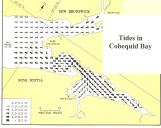
58
Guided by the currents they start to arrive in mid June and continue to arrive until mid-October. At the time of Haliday's arrival the bay teemed with shad during the summer months. Local fishermen soon adopted Haliday's method of fishing and by 1870 there were nintey boats fishing forty miles of net from Harrington River to Chiganois River. At night, it is said that these nintey boats, each with its light, gave the apperance of a floating village.
59
Store in Portapique, Nova Scotia
1970
Portapique, Nova Scotia, Canada
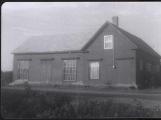
60
Shad were cleaned, split and salted in barrels and shipped to New England by boat. In 1860 there were 3495 barrels of salted shad, of two hundred pounds each, shipped from the area. Seventy-six exporters were noted in the 1861 census. The need for barrels resulted in the spin-off industry of coopering. This building in Portapique belonged to one merchant who handled salt shad.
61
A Mower and team overlooking Cobequid Bay.
1902
Portapique, Nova Scotia, Canada
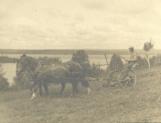
62
Many people at this time were involved in agriculture. To supplement incomes, most men fished in what became known as the "shadboat."
63
Harold Cooke haulling Shamrock to the water.
1960
Highland Village, Nova Scotia, Canada
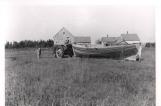
64
Fishing in the summer, was as much a part of farm life as was working in the woods in the winter. Usually, farm work was done during the day and fishing at night.
65
Russell Cooke in Shamrock
1958
Highland Village, Nova Scotia, Canada
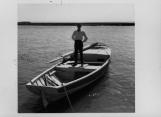
66
A farm boy would catch all the sleep he could, as he drifted down the bay, because he had hayed that afternoon and would be expected to put in time in the hay field the next day. Russell Cooke was fifteen years old in this picture and was his father's helper. Many men fished alone but an extra hand made the work easier.